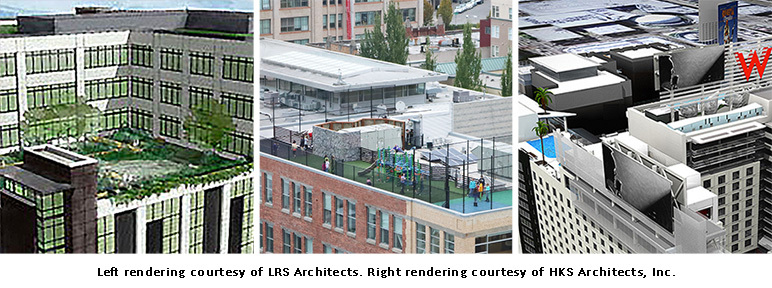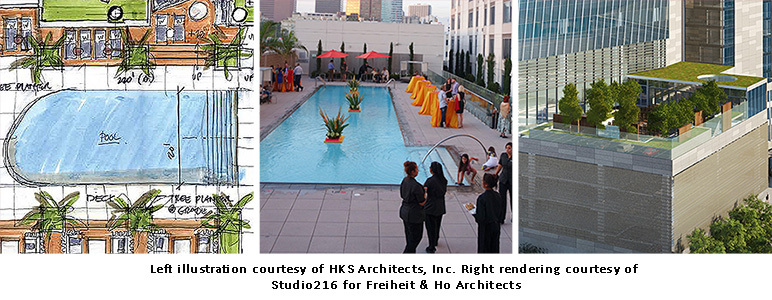Do you know how much load the roof of your building can carry? In other words, will the roof be able to resist that heavy snow fall this winter, and then support you and 25 of your neighbors when you want an unimpeded view of the aurora borealis? Will your roof support the new air conditioner you’ve finally sprung for after experiencing last summer’s heat wave?
If you have a relatively new existing building, the roof and roof support system were probably designed to handle reasonable levels of snow loads, wind loads, temporary (live) and permanent (dead) loads. If your building is older, it may have been “non-engineered” and built according to standard practice at that time, with an unknown capacity. The steepness of the roof may limit how much vertical load you can actually put on the roof without sliding off. Unless your roof bows downward like a waterlogged awning, you’ve probably never given much thought on how strong your roof is until you started thinking of turning a flat portion of your roof into a view deck with a hot tub, or replacing your mossy wood shingles with heavy terra cotta tile roofing.

A shout-out for rooftops
Whether your building is an existing structure or a new one, there are practical and aesthetic benefits from adding rooftop features or improvements. A landscaped green roof or garden deck will improve the appearance of a building, add thermal insulation, and help the overall environment by reducing urban heat island effects. If you upgrade to energy efficient HVAC systems with new rooftop units (RTUs), you can earn LEED points for developing a more sustainable building. Rooftop amenities such as roof decks, seating and lounging areas, and pools or spas will increase rental appeal of the building, particularly for office and residential buildings. Most new projects in Seattle and other areas are taking advantage of rooftop areas for more than just protection from the elements; it’s common now for rooftops to be designated spots for urban respite where tenants and workers can find escape from street level noise and congestion.
Your average roof
A roof framing system is hopefully configured with appropriately sized and spaced structural members (e.g., rafters, joists, girders, trusses, etc.) that will support commonly occurring loads. If you are constructing a new building, building codes specify minimum snow and other typical loads that a roof must be designed for, and the local building department will take steps to make sure these provisions are followed. If you have an existing building that has gone through years of snow, rain, windstorms, and regular maintenance without any signs of distress, your roof is most likely safe and will be able to handle everyday loads in the future. But if you have an existing roof that is sagging when loaded, or if you are thinking of making changes to an existing roof that will result in heavier loads, or if you are thinking of a new building that will use the roof for more than just keeping the rain out - something like a rooftop swimming pool with palm trees - you need to talk to an expert.
It’s all information and insight you can gain from a structural engineer. Here are two talking points when discussing roof loads with an S.E.
1. Let’s talk roof capacity
If you don’t have construction drawings for an existing building that specify what the roof is designed for, you will want a structural engineer to visit the site to assess the roof’s layout and framing construction. He or she can determine the roof’s general layout, member sizes, and materials, and then use engineering mechanics to calculate the current roof load capacity. With the results, S.E.s can advise you when the roof does not comply with minimal load-bearing requirements stated in current building codes. If that is the case, an S.E. can recommend ways to strengthen your current roof system. If you are thinking about making upgrades to your roof such as heavier roofing or using part of it for a roof deck, it’s possible your roof has reserve capacity to handle these additional loads. However in most cases, existing roofs have little reserve capacity and new loads will have to be limited or require strengthening to increase its load capacity.
If you are planning or designing a new building and want to consider rooftop amenities that fit within a construction budget, discuss the possibilities with an S.E. The range of load added by rooftop amenities varies greatly from under 30 pounds per square foot (psf) for a lightweight green roof to over 300 psf for a fully landscaped roof garden or rooftop pool. The cost of the roof structure will increase greatly for heavier loads in addition to the cost of the amenity itself. With an S.E. you can discuss tradeoffs in design and costs, which type of amenities have the greatest impact on cost, and how to get the most from your investment in a rooftop improvement.
2. Let’s determine constructability and cost-efficiency
Roof retrofits usually entail supporting new features, such as HVAC RTUs, solar panels, rooftop gardens, or swimming pools. Some of these features are quite heavy, and it’s likely your current roof structure may not support the weight. Enhancements such as a lightweight timber deck or a shallow roof garden can be feasible on some existing roofs without additional reinforcement. But if the existing roof lacks reserve capacity or if lightweight features will not meet project needs, reinforcement of the existing roof can be explored. Some strengthening can be done on the top of the roof deck, which avoids the disruption of interior spaces, such as the temporary removal of finishes or other tenant inconveniences. The underside of the roof can also be reinforced, and a good design should consider both the efficiency of the structural strengthening and its impact on interior finishes, building utilities, and the tenants occupying the floor below the roof. There might be even more options for you. For instance, alternative designs can propose workarounds to roof capacity, such as choosing a smaller area for constructing a roof deck where the structure has ideal support. Building materials can make for lighter loads (e.g., limit the number or area of planters or brick pavers, use lightweight soil for a garden deck). Consulting with an S.E. will help you decipher if the retrofit is allowable, feasible, and worth the investment.

The previously mentioned talking points can lead to a thorough discussion about how roof loads will affect your building. Your rooftop options depend on your project, regional factors, your vision of a desirable built environment, and your investment strategy. It’s always beneficial to speak to a structural engineer about your ideas for rooftop features. There might be more aspects to consider than you realize.
Rose Bechtold, Communications Specialist | Rose comes from a journalism and technical writing background. She is in her element while in research mode and naturally immerses herself in expert knowledge by interviewing staff members about new subjects. In her spare time, Rose practices plein-air sketching of buildings and random scenes around town.


